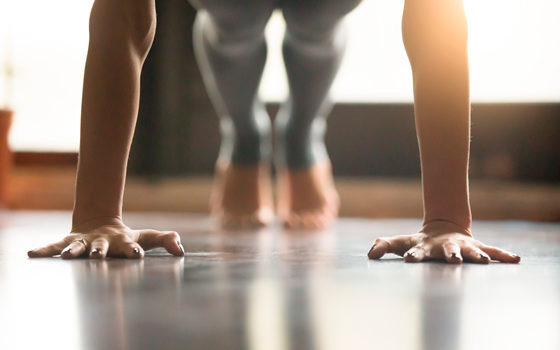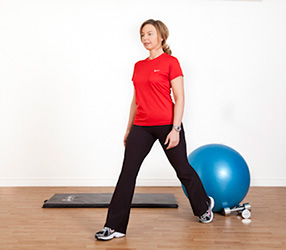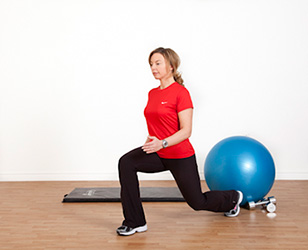Being physically fit is definitely an asset in overcoming adversity and life’s challenges.
We are all responsible for our own well-being and health, which is why it’s important to take charge of your own life. Improving your quality of life is possible, but you have to want to change… that’s why I am recommending a workout plan and various options such as Pilates, yoga, relaxation and meditation to help you improve your well-being.
When you focus exclusively on certain muscles, it creates muscle imbalances and increases your risk of injury. It is important to understand how each muscle works when performing a movement and how to move safely and effectively.
Here are instructions for each exercise using equipment (stability ball and free weights).
LUNGES
Take a big step forward to create a good distance between your feet, making sure that they are in line with your shoulders.
Stabilize your upper body by tightening your abdominals.
Keeping your trunk in an upright position, lower your back knee until it is just a few centimetres from the floor. Make sure your front leg is bent at a 90° angle and that your knee doesn’t go beyond your toes.
Main muscles involved: glutes, quadriceps and hip adductors.
STABILITY BALL HIP EXTENSION
Lie on your back.
Stretch your arms out to each side, then raise your legs over the ball and press your heels down at its centre.
Raise your hips so that your trunk, buttocks and thighs all form a straight line.
Controlling your movements, slowly raise and lower your hips.
Muscles involved: hamstrings, glutes and lumbar extensors.
BENCH PRESS ON BALL
Sit on the ball with your feet positioned slightly wider than your shoulders.
Walk your feet forward one step at a time until your upper shoulders and head are resting on the ball.
Bend your elbows 90 degrees, keeping your arms in line with your shoulders.
Simultaneously raise both dumbbells toward the ceiling.
Important: Keep your elbows slightly bent while the weights are raised.
Main muscles involved: pectoral, deltoid and triceps.
INCLINED ROWING MOTION
Bend your knees slightly and tilt your upper body forward 45 degrees. Contract your abdominals and bring the dumbbells toward your chest while keeping your bent arms in line with your body.
Return to the starting position, without fully relaxing your muscles.
Main muscles involved: dorsal, biceps, rhomboids and deltoids.
THE PLANK
Lie on your stomach with your forearms flat on the floor. Your elbows should be directly in line with your shoulders. Supported by your toes at the other end, legs stretched, lift your pelvis off the floor so that your body forms a straight line. Make sure not to arch your back. Maintain this position while tightening your abdominal muscles.
Why work out with stability ball?
Many health care professionals use a stability ball instead of a bench to help further develop the stabilizer muscles that support the joints. Working with a stability ball benefits the brain as much as the body because it helps you become aware of your posture and movements, whether you are dancing or lifting a baby. Good posture allows you to move better, improves your agility and prevents injury.
Be careful and stay focused when using the ball!
Pilates with a ball
Finding your balance on a ball might seem self-evident, but if you can’t do it, you won’t be able to perform any exercise properly. To maintain your balance, your abdominal muscles need to be strong and tight.
Pilates, a form of exercise developed by Joseph Pilates, develops core strength (the abs). This workout method increases posture awareness and corrects muscle imbalances.
Yoga: an invitation to self-discovery!
There are many reasons to practise yoga. Perhaps you want to increase your flexibility, counter the harmful effects of stress on your body, find serenity or become more spiritually attuned.
Although yoga is a lifelong practice, you can start slowly, introducing it little by little to your daily routine. When approached in this way, self-knowledge becomes a fascinating and satisfying journey of discovery!
Relaxation and meditation: companions to physical activity
Relaxation is a key component on the path to optimal health. Meditation can calm our minds, open our hearts and provide us with physical benefits that are well documented.
Physical exercise provides an opportunity to be at one with yourself and focus on your breathing. Use movement and exercise as a way to connect with the deepest parts within yourself and fully live in the present moment.
Sophie Mc Greevy
Fitness coach:










